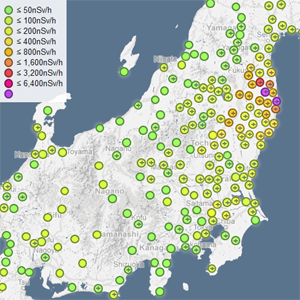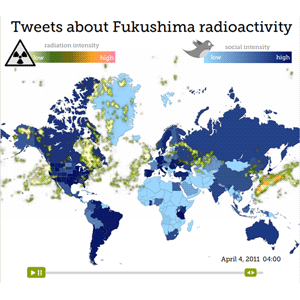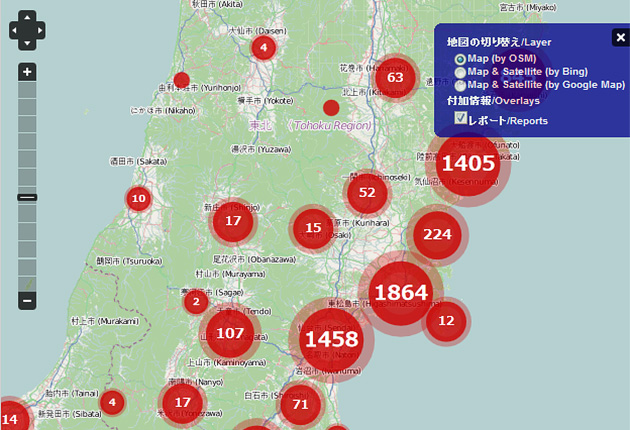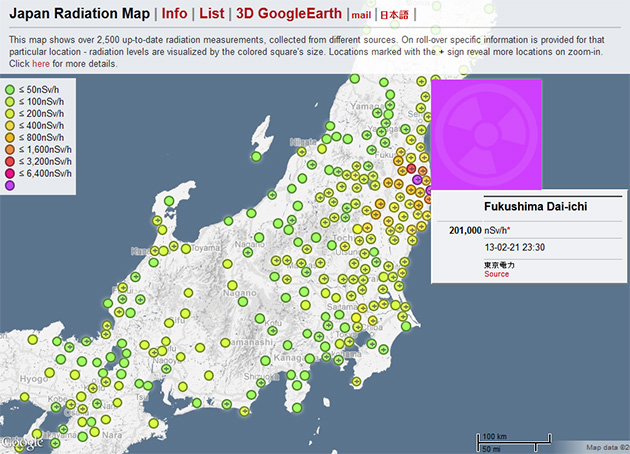Revisiting The Promise of Societal Verification in the Age of Social Media
Can the power of social media be harnessed to ensure state compliance with arms control and nonproliferation agreements?

Crowdsourced map related to the Fukushima incident. (Source: http://pub.iidj.net/)
The idea of societal verification of nonproliferation and arms control agreements has been around since the dawn of the nuclear age. Lewis Bohn and Seymour Melman first proposed the concept of “inspection by the people” in the late 1950s, arguing that engaging civil society in compliance monitoring would benefit the formal inspection process; they recommended that provisions for civil monitoring be included in all disarmament agreements. Later, authors such as Grenville Clark and Louis Sohn echoed this sentiment, and tried to establish some form of whistleblowing protection for “citizen inspectors” as part of international law. In the 1990s, physicist Joseph Rotblat famously proposed societal verification as an integral part of a global treaty to ban nuclear weapons, with whistleblowing protections added to every country’s domestic law. Corruption, entrenched interests, and immature legal systems have prevented most states from passing or enforcing even basic corporate whistleblowing laws however, so the idea of using civil society to enforce nonproliferation agreements has languished.

Animation of twitter usage plotted against Fukushima’s radioactive plume.
With the surge of developments in the realm of social media technologies over the past ten years, some are asking whether it is time to reconsider the idea. Can the estimated one billion Facebook account holders somehow be organized to watch for nuclear smuggling? Could any of Iran’s 56 million cell phone users be relied upon to send a text message to the International Atomic Energy Agency to report a violation of the Treaty on the Non-Proliferation of Nuclear Weapons? These examples sound far-fetched, but the capabilities exist today. Last July, open source imagery company, Tomnod.com, used Facebook and Twitter accounts to create a worldwide virtual search team to analyze 2.5 gigabytes of commercial satellite imagery to help locate a pair of mountain climbers who went missing in the remote Andes. The team was organized in less than forty-eight hours, and ultimately pointed search and rescue crews to a location only 1,000 feet from the bodies of the lost climbers. After the 2010 earthquake in Haiti, volunteers at Tufts University organized a crisis map on the open source software platform, Ushahidi, to help coordinate relief efforts on the ground. Using a short message system (SMS) number, victims and observers sent more than 2,500 incident reports through their cell phones, which were then used by relief workers to help prioritize and coordinate rescue efforts.
Examples such as these are numerous and seem to offer hope to the classic idea of societal verification. Yet, the fit is not perfect, especially when the promise is weighed against the real challenges of arms control. Advocates for combining social media and societal verification are demanding a great deal. At the most basic level, the hope is for a set of tools that can improve monitoring and verification efforts. Beyond that, perhaps the tools could be generally applied to boost a state or international organization’s intelligence efforts. They might also somehow make the whole effort more efficient, more transparent, and less expensive. Finally, following on the examples of the Arab Spring and Iran’s “Twitter Revolution,” there is a hope that social media can be leveraged to spread information and change minds, at least with respect to the desirability of nonproliferation and disarmament. These are tall orders from the most mature technologies, much less for a technology that tries to take advantage of social networking processes no one yet fully understands.
But beyond the theoretical and conceptual issues, there are some familiar realities that will be more difficult to overcome. First among these, at least as far as societal verification is concerned, is the fact that information passed over social networking sites is not anonymous. People who share information via social media are not immune from the risks of arrest or other reprisals faced by those using more traditional methods. Even in controlled circumstances, where companies such as Twitter have processed and removed identifying data before passing it to researchers, savvy computer scientists have been able to trace information back to its original source. Furthermore, the gateways to the Internet are controlled by states. Much has been written about the heroic efforts to overcome the “great firewall of China,” but few reporters mention that every visit to any website is duly logged in a government-owned or -controlled server.
Even dismissing the security concerns for individual whistleblowers, societal verification efforts must operate in the same social media world as the rest of us. That means a world of intentional and unintentional misinformation, dubious data quality, confirmation bias, and information overload. Just getting the word out is difficult. Despite well-publicized viral marketing sensations such as Justin Bieber or the Kony2012 campaign, there is no formula to replicate that success and guarantee the rapid spread of information and awareness about nonproliferation to millions of people, much less keep them engaged with the subject over a longer timeframe. And, those who are interested in the idea must remember the technology is available to almost everyone. We have all heard about how democracy-minded crowds used social media to organize protests in Tunisia and Egypt, but few have studied how ultra-nationalists have used the same techniques to orchestrate protests against the “liberal” policies of Vladimir Putin. There is no reason to think that pro-weapon advocates will not be using these tools as well.
Social media technologies then, at least with respect to societal verification, appear to be unreliable, uncontrollable, poorly understood, and even potentially harmful. That does not mean they cannot be useful, however. If the concept of societal verification is modified from “inspection by the people” to “with the assistance of select people,” arms control and nonproliferation efforts certainly could profit from the same processes that have lowered costs and driven innovation in the corporate world. Organizational and informational awareness, early warning of potential concerns, identification of new technologies or solutions, education, and improved collaboration are just some of the benefits. By focusing on the potential of social media to impact the broader society, we ignore the obvious benefits of these technologies to the existing expert community. Social media technologies can be an important tool to aid the nonproliferation cause. But, like any tool, it is the expert and not the amateur who can benefit most.
Bryan Lee is director of the Eurasia Nonproliferation Program at the James Martin Center for Nonproliferation Studies.


